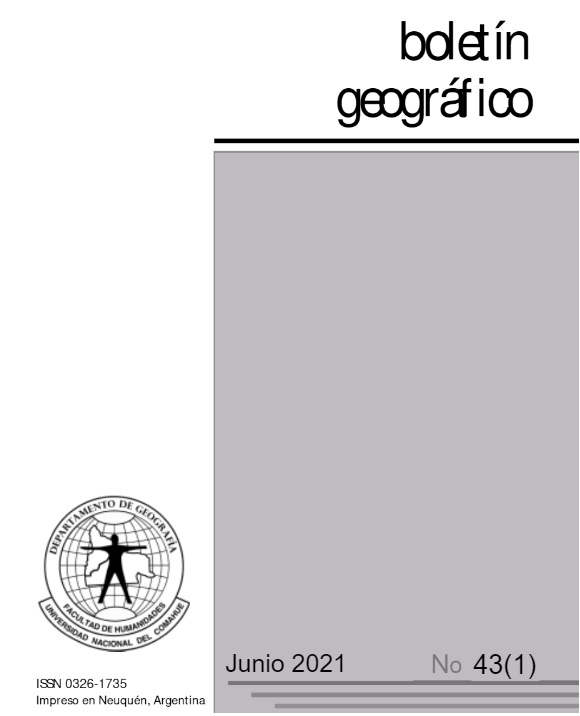Risk management and fluvial territory. Case of the San Bernardo stream
Keywords:
Fluvial territory, Land use, Risk, Small basinsAbstract
The fluvial territory refers to the space or landscape dominated by a fluvial system and includes the channel, the riparian corridor and the flood plain. Its limits are precise, but not permanent since it is necessary to modify them according to river mobility. The determination of the river territory is a complex task, although from the theoretical point of view it is a simple proposal, it is very difficult to put it into practice, mainly in large basins. This can be observed in our country, where the methodology has not yet been concretely implemented in any basin. The objective of this work is to delimit the fluvial territory in an urbanized section of the San Bernardo stream basin to be used as an input for the future management of this space in the face of the problem of floods that repeatedly affect the area. For the delimitation of the river territory, geomorphological (inclusion of land susceptible to being eroded in the coming decades due to the dynamics of the riverbed), ecological (inclusion of isolated riverine vegetation masses and other fluvial annexes disconnected from the riverine corridor) and historical criteria were used (changes in land use and floodplain for a return period of 50 years). These criteria were applied in a section of the lower basin of the San Bernardo stream. This choice is based on the fact that there is the greatest impact given the presence of the town of Sierra de la Ventana. Considering that, the river territory is a tool that can be used in the incipient management of water resources that is being carried out in the basin, it is considered appropriate to start applying the methodology in the section with the greatest impact and then continue with the rest of the basin. As a result, an Ideal Fluvial Territory of 548 m2 was obtained in which it is necessary to manage the banks since they are the spaces most affected by the anthropization of the area.
Downloads
References
Alonso Sarría, F., Gomariz Castillo, F., Cánovas García, F., y Moreno Brotóns, J. (2020). Análisis espacio-temporal de los cambios de usos del suelo en la Cuenca del Río Segura. Congreso internacional sobre desertificación. Physical Geography Modelling.
Arnaud-Fassetta, G. y Fort, M. (2008). The integration of functional space in fluvial geomorphology, as a tool for mitigating flood risk. Application to the left-bank tributaries of the Aude River, Mediterranean France. 4th ECRR Conference on River Restoration. Venice, Italy.
Baena Escudero, R., Guerrero, I., García Martínez, B., y Posada, C. (2016). Anthropogenic occupation and risks of flood in the plains of the Guadalquivir river (Palm sector of river-Sevilla, Spain). Boletín de la Asociación de Geógrafos Españoles ,72, 149-167. http://dx.doi.org/10.21138/bage.2335
Bazin, P.,y Gautier, E. (1996). Un espace de liberté pour la Loire et l'Allier: de la détermination géomorphologique à la gestion/Optimum streamways for the Loire and Allier. Géocarrefour, 71(4), 377-386.
Biron, P. M., Buffin-Bélanger, T., Larocque, M., Choné, G., Cloutier, C. A., Ouellet, M. A., Demers, S., Olsen, T., Desjarlais, C. y Eyquem, J. (2014). Freedom space for rivers: a sustainable management approach to enhance river resilience. Environmental management, 54(5), 1056-1073.
Blackwell, M.S.A. y Maltby, E. (2006) Ecoflood guidelines. How to use floodplains for flood risk reduction. Luxembourg, European Community, EUR22001.
Brendel, A. S., Bohn, V. Y. y Piccolo, M. C. (2017). Variabilidad de la precipitación y su relación con los rendimientos agrícolas en una región semiárida de la llanura pampeana (Argentina). Estudios Geográficos, 78(282), 7-29.
Cabrera, A. (1976). Fitogeografía de la República Argentina. Sociedad Argentina Botánica,
Cadierno Gutiérrez, J. (2014). Análisis y planificación de zonas inundables. Estudio de caso: Quebrada y Canal de Ramón, Santiago de Chile. Geographicalia, 66, 21-44.
Campo, A., Capelli, A. y Diez, P. (2004). El clima del Suroeste bonaerense. Bahía Blanca, Argentina: Ediuns.
Casado, A. y Campo, A.M. (2019). Extremos hidroclimáticos y recursos hídricos: estado de conocimiento en el suroeste bonaerense, Argentina. Cuadernos Geográficos, (58), 6 – 26.
Casado, A. y Piccone, N. (2018). Aplicabilidad de los datos grillados para el análisis espacio temporal de las precipitaciones, provincia de Buenos Aires (Argentina). Párrafos Geográficos, (17), 46 – 62.
Choné, G. (2013). L’espace de mobilité des rivières du sud du Québec: implications pour les écosystèmes et la gestion des rivières dans une perspective de changements climatiques Tesis posgrado. Concordia University.
Ferreli, F. y Aliaga, V. (2015). Variabilidad de las precipitaciones y sus efectos sobre la respuesta espacio- temporal de cuerpos de agua en la región pampeana, Argentina. Tesis de especialización. Luján, Argentina.
Gatica Herrera, M., Pulgar Salamanca, F., Correa Román, H. y Díaz Valenzuela, L. (2019). El territorio fluvial como instrumento de prevención del riesgo de inundación en la ribera sur del Río Laja, en la comuna de Laja. Revista Latinoamericana de Estudiantes de Geografía, 6, 64 – 73.
Gentili, J. y Gil, V. (2013). Variabilidad temporal de las precipitaciones en vertientes opuestas del Sistema de Ventania, Buenos Aires, Argentina. Revista Universitaria de Geografía, 22, 147 – 166.
Gil, V. (2010). Hidrogeomorfología de la cuenca alta del río Sauce Grande aplicada al peligro de crecidas. Tesis posgrado. Departamento de Geografía y Turismo, Universidad Nacional del Sur.
Gil, V., Gentili, J.O., Zapperi, P.A. Casado, A. L. y Campo, A.M. (2008). Aspectos geomorfológicos e hidrometeorológicos en cuencas serranas, Suroeste de la provincia de Buenos Aires. En: Utilización de tecnología, Jornada SIG GIS Day, Bahía Blanca, Argentina.
González del Tánago, M. (2007). Las alteraciones geomorfológicas de los ríos. Estrategia Nacional de Restauración de Ríos: Universidad Politécnica de Madrid.
Martínez Castroviejo, R. Gómez Villar, A. y García Ruiz, J.M. (1991). Ajustes fluviales derivados de cambios de uso del suelo en el pirineo aragonés. Cuaternario y Geomorfología, 5, 91-105.
Moretto, B., Gentili, J. O., Ortuño Cano, M.A. y Campo, A. M (2019). El agua: recurso y peligro. Análisis normativo-institucional para la vertiente norte del Sistema de Ventania (Argentina). Geográfica Digital, 16 (31), 29 – 45.
Ollero Ojeda, A; González, A y Elso, J. (2009). El territorio fluvial y sus dificultades de aplicación. Geographicalia, 56, 37-62.
Ollero, A. y Elso, J. (2007). The need for a “fluvial territory” or “room for the river”: living with floods by acceptance of their functions. In Baker, C. y van Eijk, P. (eds.) Sustainable flood management: obstacles, challenges and solutions, 59-63, Maastricht, Interreg IIIC Network FLAPP.
Ollero, A., Ibisate, A., Acín, V., Díaz, E., Granado, D. y Horacio, J.
(2011). Innovación y libertad fluvial. VII Congreso Ibérico sobre Gestión y Planificación del Agua “Ríos Ibéricos +10. Mirando al futuro tras 10 años de DMA”. Talavera de la Reina, España.
Rohde, S., Hostmann, M., Peter, A., y Ewald, K. C. (2006). Room for rivers: An integrative search strategy for floodplain restoration. Landscape and Urban Planning, 78(1-2), 50-70.
Sandoval Erazo, W. y Aguilera Ortiz, E. (2014). Determinación de caudales en cuencas con poca información hidrológica. Revista Ciencia UNEMI-Ecuador, 7(2), 100-110.
Sellés Martínez, J. (2001). Geología de la Ventania. Provincia de Buenos Aires, Argentina. Journal of Iberan Geology, (27), 43-69. Recuperado el 07 de octubre de, http://revistas.ucm.es/index.php/JIGE/article/view/JIGE0101110043A
Suero, A. (1972). Geological compilation of Sierras Australes (Buenos Aires Province, Argentina). Laboratorio de Entrenamiento Multidisciplinario para la Investigación Tecnológica (LEMIT), Buenos Aires.
Terneus-Jácome, E. y Yánez, P. (2018). Principios fundamentales en torno a la calidad del agua, el uso de bioindicadores acuáticos y la restauración ecológica fluvial en Ecuador. La Granja: Revista de Ciencias de la Vida, 27(1), 36-50.
Vandemeulebrouck, P., Arnaud-Fassetta, G., y Fort, M. (2011). " Espace de liberté" et" gestion douce": deux concepts naturalistes complémentaires dans la lutte contre les inondations. Le cas de l'Ognon. En Risques naturels en mediterranee occidentale actes du Colloque International. Carcassonne, Aude, Languedoc-Roussillon, France.
Volonté, A. (2017). Geomorfología fluvial aplicada al peligro de crecidas. Cuenca del arroyo San Bernardo, Sistema de Ventania, Argentina. Tesis posgrado. Departamento de Geografía y Turismo, Universidad Nacional del Sur.
Volonté, A., Duval, V., Gil, V. y Campo, A. (2013). Vegetación ribereña en la cuenca baja del arroyo San Bernardo, Sierra de la Ventana. Trabajo presentado en el Congreso Int. de Geografía, 74° Semana de Geografía, Trevelin, Chubut.
Zapperi, P., Ramos, M., Gil, V. y Campo, A. (2007). Caracterización de las precipitaciones estivales en el Suroeste bonaerense. Contribuciones Científicas, 1(2), 483 - 491.
Published
How to Cite
Issue
Section
License
Copyright (c) 2021 Boletin GeográficoTransfer of rights and data processing
The acceptance of an article for publication in the Journal Geographic Bulletin implies the cession of the rights of printing and reproduction, by any means and means, of the author in favor of the Department of Geography of the National University of Comahue, which will not reject any request reasonable for the authors to obtain permission to reproduce their contributions. The total or partial reproduction of the works published in the Geographic Bulletin must be done citing the origin, otherwise, the copyright is violated.
Likewise, it is understood that the concepts and opinions expressed in each work are the sole responsibility of the author, without being responsible or in solidarity, necessarily, neither the editorial staff nor the editorial staff.
It is the responsibility of the authors to be able to provide interested readers with copies of the raw data, procedure manuals, scores and, in general, relevant experimental material.
Likewise, the Management of the journal guarantees the appropriate treatment of personal data
COPYRIGHT TRANSFER FORM















 Journal of the
Journal of the 